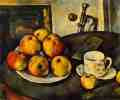![]()
 Still Life with Apples
Still Life with Apples
1890-94 (130 Kb); Oil on canvas, 18 1/8 x 21 5/8 in; Private Collection, U.S.A.
A very different approach to still life than the last is the extraordinary search for compactness and solidity in this work. It is hard to remember another painting of fruit so densely colored and so appealing to the touch. Yet reality is sacrificed here in many details, not for the pleasure of fantasy but for the sake of a more concentrated, coherent painting of what exists very close to the eye. The dish under the apples disappears abruptly at the right; the ellipse of the round table flattens and contracts oddly behind the plate; the saucer has a corresponding asymmetry; the second row of apples is tangent to the first in a way that contradicts their supposed positions behind the latter and in contact with the plate.
Why could not Cézanne have continued the plate on the right, simply darkening its color and compensating in the nearby objects? Would this have weakened the composition? Hardly, for so inventive a composer as Cézanne. But in this picture the silhouettes resulting from the distortions are so powerfully coherent that we cannot (and do not wish to) imagine an alternative. Important here seems to be the desire for variation: the right side of the dish with symmetrically placed apples is distinguished from the left, just as the symmetry of the cup is broken by the handle, and the two sides of the saucer are remarkably unlike. On the left, the dish emerges from under the apples; on the right, the apples completely cover the dish, and the contrast of their color with the bluish white dish is displaced to the small arc against the light wall. The contours of the apples, round and angular, are opposed more sharply to the adjoining card and saucer. What is paradoxical is that a man so free with real forms should also be so devoted to the constant qualities of things.
The dish of apples is a wonderfully realized piece of painting. One should observe the different posture of each apple. Together they are a symmetrical formal group in which each member is tilted in its own way. And what is more original, each is modeled distinctively, with unique transitions of rich color and light and shade. The dark spots of the stem ends, like the poles of rotating spheres, form an interesting group. We appreciate the qualities of these apple-forms against the flatness and the straight lines and larger, shallower curves of the surrounding objects. With their round contours the apples form a triangle unique in the canvas. It has a kind of perspective in the convergence of the outlines to the vertical jamb of the fireplace. Beside it at the right is another approach to depth through the succession of overlapping objects with shifting axes in vertical alignment--apple, cup and saucer, card, poker and tongs. Within this series Cézanne has created a secret counterpoise of small accents through the shadows. The varied directions of the brush strokes too are a decided factor in the construction of the whole.